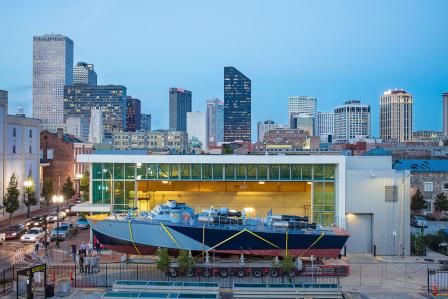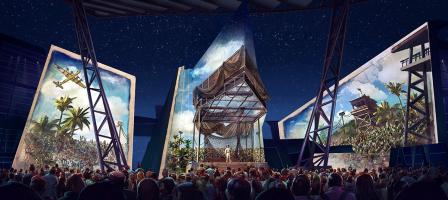
Archived Content
This site contains information that has been considered archived and will no longer be updated.
The National World War II Museum Uses Unique Ways to Teach History
The National World War II Museum in New Orleans, Louisiana, isn’t your traditional museum. Leaders pride themselves in using unique, innovative methods to share history with visitors.
“It’s a great place to inspire young people through the stories of a generation who sacrificed and saved the world from tyranny,” said Becky Mackie, Executive Vice President and Chief Operating Officer.
It’s not just pictures, panels to read, and artifact displays, but instead the museum uses immersive environments, interactive exhibits, and cinematic experiences to educate visitors on the war.

“When you walk into our Guadalcanal exhibit you sense that you are walking into a jungle, you hear the sounds and see the scenery of the jungle while learning WWII stories through first person accounts and curated exhibits,” Mackie explained. “When you sit in the Solomon Victory Theater watching the 4-D movie Beyond All Boundaries, the harsh weather our troops encountered is emphasized as snow falls from the ceiling during the Battle of the Bulge.”
Originally created as the National D-Day Museum, the museum was officially designated the National World War II Museum by an act of Congress in 2004.
Today, the seven-acre campus in a former warehouse district in New Orleans, continues to grow and attract thousands of visitors every year. Three separate EDA investments have supported the museum, helping to boost attendance, create new jobs for the community, and support the economic driver.
In 2007, an EDA grant helped to fund the museum’s first major expansion. A $1.2 million investment supported the technology components of the Solomon Victory Theatre.
“It highlights the history of World War II in 45 minutes with a dynamic, 4-D theatre experience. In the year after we premiered Beyond All Boundaries, our attendance grew 200%,” Mackie said.
In 2010, EDA again supported the museum through a $2 million grant for the Kushner Restoration Pavilion. The building features glass exterior walls that allow the public a behind-the-scenes view of the restoration and preservation of World War II artifacts, including PT-305, a patrol-torpedo boat. In addition to creating a place to expand restoration work, the pavilion created an additional 20 jobs, increasing the museum’s average wage by $3,000 per person.
The most recent, EDA investment was an $824,000 grant for infrastructure for the museum’s new Expressions of America experience. The exhibit will use mapped projection lighting on surfaces of the buildings to tell the story of the war through first-person experiences of individuals who served at home and abroad, stories told through their letters, and the story of Bob Hopes gift of humor to the troops during the war. It’s scheduled to open on Veteran’s Day later this year.

“It’s an opportunity for us to engage younger audiences as well as those looking for a unique experience, and it will open the campus for a visitor experience at night,” Mackie said.
As the museum completes its brick-and-mortar exhibit and educational facilities, it is also expanding its focus to make exhibits accessible to the audience that isn’t able to visit the museum in person. The museum is digitizing its archives and collections and making the collection accessible on the museum’s website.
It’s all in an effort to make sure our country’s past isn’t soon forgotten. “As a nation we always want to learn and know the history behind what made us,” Mackie said.
